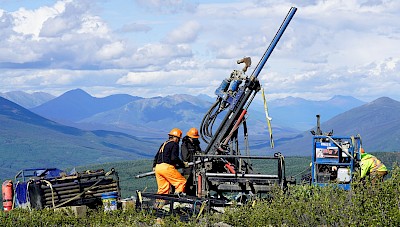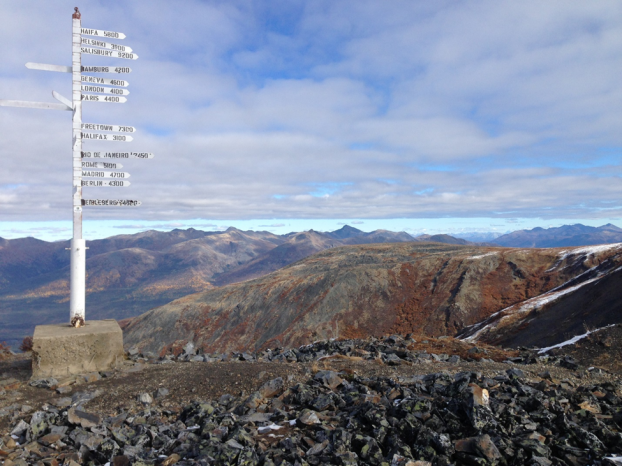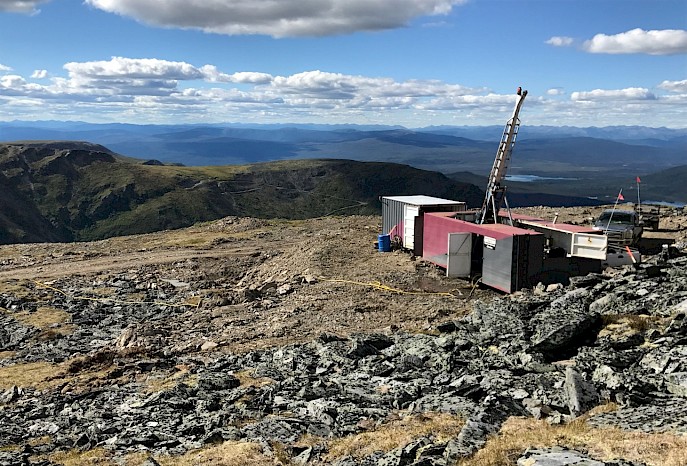
The 100%-owned Keno Silver project consists of 171 Sq Km adjacent to Hecla Mining’s mining operations in the historic Keno Hill Silver District of Canada’s Yukon Territory. The Keno district has produced over 200 Moz of high-grade Ag and currently hosts well over 100 Moz Ag.1 The area features excellent infrastructure with access via highway, well-developed and maintained roads on the property and access to the Yukon power grid. Metallic Minerals' land package covers the eastern portion of the district, along with sections on the western and southern sides, and was host to eight historical Ag mines with some of the highest grades in the district and five that had average production grades above 5,000 g/t.1
An inaugural Inferred Mineral Resource Estimate announced in February 2024 shows the Keno Silver project to host 18.2 Moz AgEq grading 223.0 g/t AgEq (120.0 g/t Ag, 0.10 g/t Au, 0.80% Pb and 1.77% Zn)2 in four shallow deposits, each of which remains completely open at depth and along strike. Subsequent campaigns, anticipated to continue in the 2025 field season, will focus on resource expansion through the drilling of extensions to current deposits, definition drilling of very prospective early-stage drilled targets to new resources, as well as targeting new discoveries at high-priority targets that have yet to be drill tested.
Typical Ag deposits in the Keno Hill Silver District consist of high-grade Ag veins, typically 1-5 m in width, grading from 200 g/t to >5,000 g/t Ag, with associated Pb and Zn sulphides. The largest individual deposits in the district, which range from 10 Moz to 100 Moz of contained Ag1, are associated with northeast trending, southeast dipping fault/vein structures that form major ore shoots in the preferred host rocks, Keno Hill quartzite and Triassic greenstone.
However, Metallic Minerals’ drilling in the eastern most part of the district confirmed the presence of typical high-grade “Keno-style” occurrences but contained within broad continuous zones of potential bulk-tonnage Ag mineralization. These results expand the known extent of drill-defined Keno-style mineralization by 10 kms to the east and south of the historic Keno Hill mine and open this major new area of prospective stratigraphy for exploration. The occurrence of mineralization within broad areas of brecciation and pervasive silicification has also expanded the potential favorable host rock settings beyond the main Keno Hill quartzite and greenstones in this area. Multi-kilometer-scale soil anomalies spatially correspond with large geophysical magnetic low features across multiple stratigraphy’s that may represent magnetite destructive alteration zones or proximal, buried mineralizing intrusive bodies.
The geologic setting at East Keno appears to be like those hosting some of the world’s largest bulk-tonnage Ag deposits, including Newmont’s Peñasquito, Fortuna’s Caylloma, and SSR’s Chinchillas deposits, which are hosted in breccia, fracture, and stockwork structural zones, as well as higher-grade sheeted veins and structures.
Project Highlights
The inaugural Inferred Mineral Resource Estimate announced in February 2024 demonstrates the potential of the Keno Silver project to host significant starter resources with 18.2 Moz AgEq (120.0 g/t Ag, 0.10 g/t Au, 0.80% Pb and 1.77% Zn)2in four shallow deposits, each of which remains completely open at depth and along strike (see Mineral Resource Estimate table here).
The 2024 mineral resources represent the equivalent of several years of production through the Keno area mill based on production guidance provided by Hecla which is planning to mine up to 3 Moz of Ag at Keno in 2024. 3
Having identified the productive structures and defined starter resources, the Company expects to be able to add significant ounces during subsequent drill campaigns.
The Keno Silver Project 2024 Inferred Mineral Resource Estimate is a considerable milestone following initiation of exploration in 2017 by the Company on the largely unexplored and previously unconsolidated property. The resource is the culmination of only 19,701 m of drilling in 168 drill holes over six active field seasons.
Metallic Mineral’s contribution to exploration expenditures is approximately $20 million. With the 2024 Inferred Mineral Resource Estimate the Company has demonstrated a highly successful systematic and efficient approach to discovery and resource delineation with approximately 921 AgEq Oz/m drilled (680 AgEq Oz/m delineated when including historic drilling).
Footnotes



